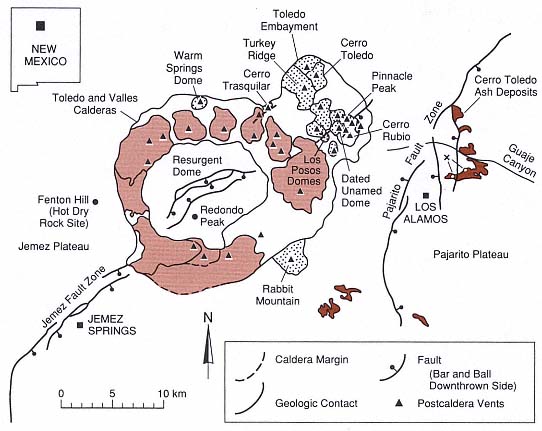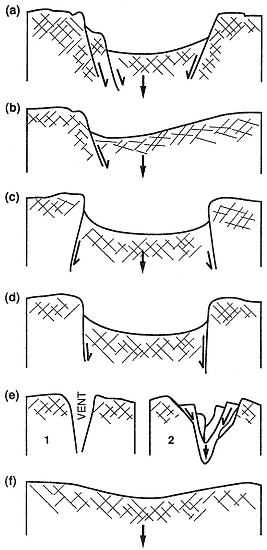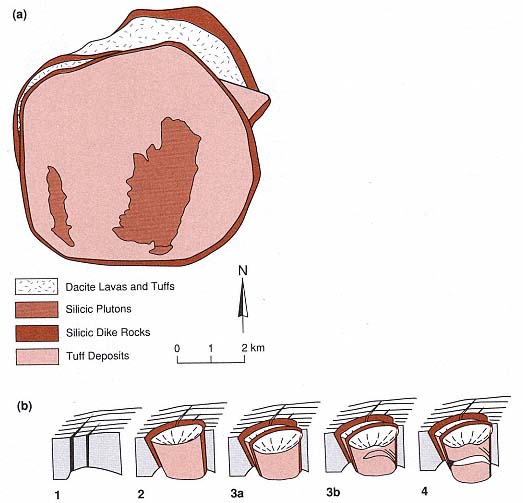Caldera Structure and Shape
The "ideal" caldera, formed during an eruption through homogeneous, unstressed rock units, is circular in plan view and plug or broadly funnel shaped in cross section (Anderson, 1936). However, the upper crust of the Earth is neither physically homogeneous nor unstressed. Caldera structure and shape are affected by prior structural trends, the depth to which the magma body has intruded, the physiographic expression of the precaldera volcanic field, and the energy of the eruption itself. Caldera complexes formed by multiple, overlapping calderas are common.
Figure 4.13 provides a cross-section view for a variety of caldera shapes. The most common caldera type is that of a subsided, semicylindrical block that is marked at the surface by concentric normal faults. In cross-section—shown in (a)—the subsiding block drops along concentric faults piece-meal, resulting in a structure that looks like the step-like seats of a stadium. In most of these calderas, the ring fault marks the actual caldera wall, but the en echelon faults of slump blocks extend out to the topographic rim. Rarely, if ever, are these calderas circular; most are oval or polygonal. The Aira and Ishizuchi calderas of Japan (Aramaki, 1984; Yoshida, 1984) and the Minoan caldera of Greece (Heiken and McCoy, 1984) are polygonal; the caldera walls follow trends of regional faults and fractures present long before those eruptions occurred (Fig. 4.14). Long Valley caldera in California, an east-west-trending oval, is almost polygonal; it is located at the intersection of major north-northwest-trending fault zones that mark the eastern boundary of the Sierra Nevada and an east-west offset in those fault zones. The giant Cerro Galan caldera of Argentina, a north-south-trending elongate oval, is adjacent and parallel to a north-south-trending rift in the Andean altiplano (Francis et al ., 1978). Most calderas exposed by either erosion or drilling fit this general model of a down-dropped block. However, there are variations on the geometry of the down-dropped block or "plug," including those with vertical faults and reverse faults that dip outward rather than inward, as depicted in Fig. 4.13 (c) and (d).
Trapdoor calderas, in plan view, are similar to the plug-like calderas and show the same variation in shape. In cross section, however, they are very different: collapse is asymmetric and one side is much lower than the other [Figs. 4.13(b) and 4.15]. Faults may mark both sides, but one side is more of a flexure or "hinge" than a fault—thus the term "trapdoor."
Nielson and Hulen (1984) and Heiken et al . (1986) interpreted the Valles caldera of New Mexico as a trapdoor caldera. It overlaps the margin of the Rio Grande Rift, where depth to the Precambrian basement is 700 m below the western caldera margin and perhaps as much as 3 km below the eastern caldera margin. In this case, the asymmetric collapse appears to be related to the distribution of underlying rocks and rift margin faults; the competent basement rocks at shallow depths act as the hinge. Many of the intermediate-size calderas in Japan (~10-km diameter), interpreted as funnel shaped, were formed not by the sinking of a cylindrical block but by the piecemeal collapse of roof rock, as is

Fig. 4.12
Sketch map of the Valles/Toledo caldera complex, showing postcaldera rhyolite domes.
The stippled pattern represents Toledo-age domes (1.0 to 1.4 myr); the light brown shading indicates
Valles domes that range in age from slightly less than 1 million years to ~100,000 years.
Triangles mark the vents of intracaldera volcanoes.
illustrated in Fig. 4.13(e). An example of this type of caldera is the Shishimuta caldera of the Hohi volcanic zone in Kyushu, Japan (Kamata, 1989). This structure formed during the eruption of the Yabakei pyroclastic flow 1.0 million years ago, during which 110 km3 of tephra were erupted. The Shishimuta caldera is 8 km wide and >3 km deep. Much of the caldera fill is an andesitic breccia made up of fragments and slabs of precaldera rocks, which is overlain by 500-m-thick lacustrine deposits. There is no evidence of structural resurgence at the Shishimuta caldera. Kamata (1989) proposed that the caldera fill is primarily composed of explosively disrupted roof rock and that there is little collapse.
Small calderas, often associated with cones or tuff rings, may form when vent walls collapse into a vent that has widened during an explosive eruption [Fig. 4.13(e)]. Vent wall collapse is common in diatremes, which are the vents for small, explosive eruptions (usually phreatomagmatic) of basaltic, alkalic, or kimberlitic magmas. Such craters, however, are formed by explosive activity and the disruption of vent walls rather than by collapse over shallow magma bodies and therefore rarely have geothermal potential. By strict definition, they should not be termed calderas.
Walker (1984) has proposed that the simplest and most poorly developed

Fig. 4.13
Sketches of possible caldera shapes in cross-
section; both observed and inferred shapes
are presented here. (a) Normally faulted down-
dropped block, observed in most continental
calderas. (b) Trapdoor caldera, in which most of
the collapse occurs along one margin and the
other margin acts as a "hinge." (c) Collapse
along outward-dipping faults, as seen in some
eroded calderas in Great Britain (Anderson, 1937).
(d) Caldera subsidence along piston-like
vertical faults (inferred). (e) Collapse into a small
vent eroded during explosive eruptions, as
exhibited by some maar volcanoes and
kimberlitic diatremes; many volcanologists
would not call these calderas. (f) Simple
downsag, or flexure, without faulting; this
caldera type was proposed by Walker (1984).
(Adapted from Walker, 1984.)
calderas are "downsagged" and have little or no development of ring faults [Fig. 4.13(f)]. Walker's chief example is Lake Taupo in New Zealand, where an enormous eruption, 1800 yr BP, formed a broad, shallow depression 30 km in diameter and 300 to 500m deep. This interpretation must be considered inconclusive because the only evidence is a saucer-shaped surface expression; little is known about the extent or thickness of any possible caldera fill within the Taupo caldera.
Many of the Earth's large calderas are not single features, but caldera complexes, which are composed of adjacent or overlapping craters formed during multiple eruptions. For instance, the Yellowstone region in the United States comprises three overlapping calderas that were formed during three major eruptions that occurred at intervals of ~600,000 years. Calderas of the San Juan Mountains in Colorado, shown in Fig. 4.16, often form clusters with considerable overlap. In many cases, caldera complexes have been mapped earlier as single calderas. One can determine if a crater is composed of one or several calderas by identifying the number and ages of ignimbrites surrounding the crater. If there is only one ignimbrite, it was most likely erupted during formation of a single caldera. If there are multiple ignimbrites with considerable time gaps between eruptions, there is a very high probability of multiple, overlapping calderas. For many years, geologists believed that Toba caldera in Sumatra was formed during one eruption. However, recent work on Toba demonstrated that it is a composite caldera that formed during three major eruptions of silicic ash (Knight et al ., 1986; Chesner, 1988).
Some caldera complexes have formed not as overlapping craters, but through multiple collapses of the same crater. The Valles and Toledo calderas of New Mexico were formed during two major eruptions 400,000 years apart; the eruptions were of similar

Fig. 4.14
(a) Structural map of the Ishizuchi caldera in Japan. The polygonal shape created during
caldera collapse follows the general structural grain of precaldera rocks. Faults and
fractures present before the caldera-forming eruption often control the caldera shape.
(b) Block diagrams showing stages of development of the Ishizuchi caldera.
(Adapted from Yoshida, 1984.)
magnitude and each deposited pumice falls and pyroclastic flows. These eruptions may have buried several older but smaller calderas. Drilling within the Valles/Toledo caldera complex revealed two main sequences of caldera tuff deposits and several smaller deposits—a pattern that usually correlates with tuff sequences surrounding the calderas. The younger caldera (the Valles) appears to have collapsed along the same faults as the older caldera, so that one lies on top of the other.